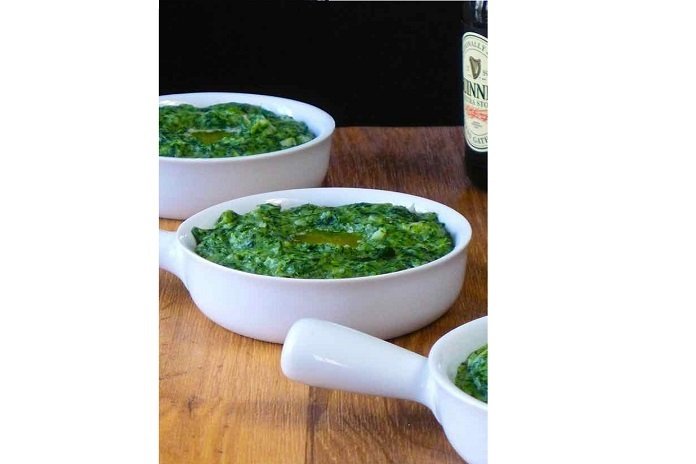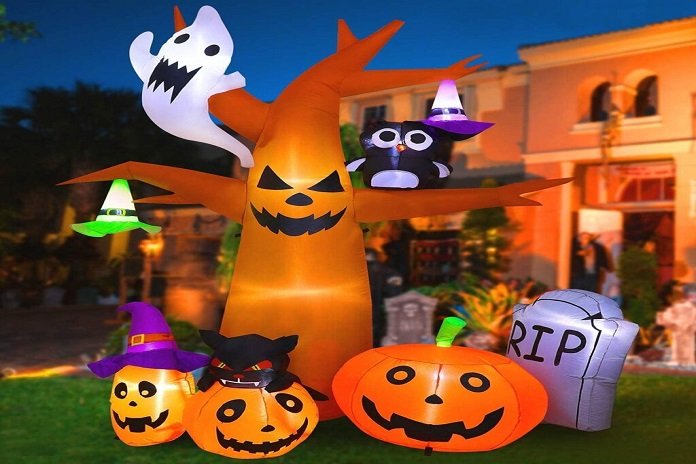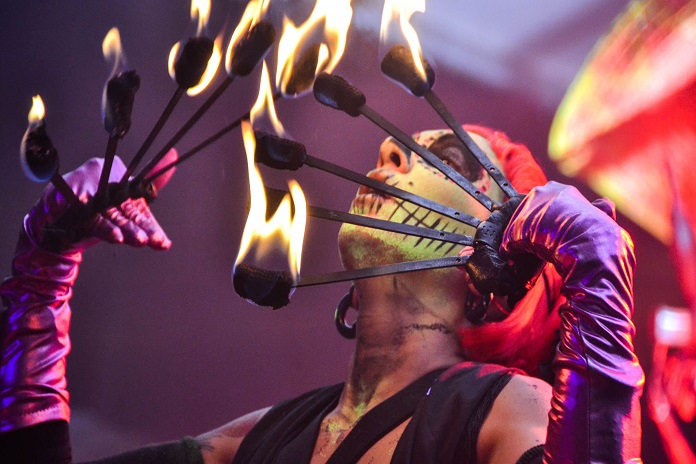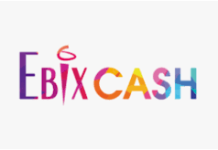Ireland isn’t short of a ghost or three, and Halloween is the perfect time for eerie encounters. Haunted houses, cursed castles and all manner of spooky spaces are to be found across the island of Ireland. Each with their own tale to tell, they attract lovers of the supernatural who are keen to glimpse a ghost or feel the chill of a spirit’s breath.
Loftus Hall in County Wexford in Ireland’s Ancient East, is said to be the most haunted building in Ireland, the place where the Devil himself came calling in disguise.
If you want to see what happens in Loftus Hall after dark you can view a live stream from six rooms every night. And on 10 October there will be a special live streaming event of a Halloween paranormal lockdown, when an experienced team of paranormal investigators will try to make contact with the spirits.
Built by the Shaw family in 1625, historic Ballygally Castle, located on the spectacular Causeway Coast in Northern Ireland, is famous for the ghost that resides in its haunted tower. Lady Isobel Shaw was locked in the tower by her husband because she did not produce a male heir and, rather than starve, leapt to her death.
Today the castle is a luxury hotel and many guests claim to have seen her ghost and felt the presence of other spirits.
Tales of witchcraft, revenge, demonic rituals and betrayal abound in the beautiful medieval city of Kilkenny, which was named one of most haunted places in Europe by a travel magazine. At least two of its buildings are said to be haunted by the same ghost, the spirit of Alice Kyteler, who was accused of being a witch but fled the city, leaving her maid to be burned at the stake in her place.
Alice’s ghost, or some believe that of her maid, is often glimpsed in Kyteler’s Inn, Kilkenny’s oldest inn which was established by Alice around 1323. Her ghost also frequents St Canice’s Cathedral. On Ireland’s Wild Atlantic Way, the echoes of those imprisoned by the sixteenth-century pirate queen Grace O’ Malley can seemingly be heard in the dungeons of Westport House in County Mayo. The stunning stately home is built upon the foundations of one of O’ Malley’s castles and offers self- guided tours.
Imposing Dublin Castle claims no ghosts but has strong links to one of the masters of the macabre, Bram Stoker, author of Dracula.
Born at the height of the Great Famine, Stoker worked in Dublin Castle and is said to have been inspired to write Dracula by the tales of the undead that his mother told him and references to Ireland’s starving people as the walking dead.
Every Halloween Dublin stages the Bram Stoker Festival, a vampire-themed horrorfest in his honour which this year will feature a series of both live and online events. www.ireland.com
Celtic Ireland, Where Halloween all began
Halloween is coming – but did you know it is Ireland we have to thank for the most popular customs and traditions at the most unearthly time of year?
The Irish are famous for concocting a bewitching cauldron of mystery and merriment at Halloween ime, and little wonder, Ireland is where it all began. Trace Halloween to its origins and you will arrive right back in the mists of Ireland’s Ancient East and the Celtic festival of Samhain, a great celebration of fire and feasting that marked the end of the season of light and the beginning of the dark days of winter.
At this moment of transition, the Celts believed there was an interaction between the worlds of the living and the dead and that spirits could move between them. Fearing that all manner of beings might pull them into the otherworld before their time, the Celts would disguise themselves in costumes to confuse and scare off the roaming ghosts, fairies, hobgoblins and demons.
The modern practice of dressing up at Halloween is firmly rooted in these old pre-Christian Celtic customs, as is the tradition of lighting bonfires, which began on hilltops in Ireland with clans and communities gathering to light huge ceremonial Samhain fires.
One of the biggest Celtic festivals of fire was at the peak of Tlachtga, or the Hill of Ward in present day County Meath. Recent archaeological excavations suggest the hill was used for feasting and celebration over 2,000 years ago and old manuscripts reveal that the Celts lit a fire here from which all the fires in Ireland were rekindled.
To this day the area around the Hill of Ward, and the nearby Hill of Tara where the High Kings of Ireland ruled, remains one of the centres of Irish Halloween traditions. The Púca Festival, a twenty- first-century Samhain celebration, is held in County Meath and neighbouring County Louth every year.
Celebrating Ireland as the birthplace of Halloween, Púca events normally include an impressive re- enactment of the symbolic lighting of the Samhain fire, live music and performance, amazing light installations and more. This year, however, the celebrations will be virtual, with a broadcast of the lighting of the Samhain fires due to take place on 31 October. Lit up pumpkins with ghoulish faces is another much-loved aspect of Halloween. The practice of carving them began in Ireland, where turnips and large potatoes served as the original Jack-o-lanterns.
In fact, the name of the Halloween decoration comes from an Irish folktale about a man named Stingy Jack who played a trick on the Devil. As a punishment for his trickery, the Devil doomed Jack to wander eternity with only a burning ember from the everlasting fires of Hell inside a turnip to light his way. Irish immigrants eventually brought the tradition to America, home of the pumpkin, and the winter squash has now become integral to the Halloween festivities.
Trick or treating is another Halloween tradition originating in Ireland, in this case with children and the poor going from door to door to ask for food, kindling or money. They sang songs or offered prayers for the soul of the dead in return for food, usually a soul cake which was a flattened bread that contained fruit. This tradition was known as ‘souling’.The custom of dressing in costumes and making house visits to request small presents of sweets, fruit and money is alive and well in Ireland today, and in many other countries around the world.
Traditional food for an Irish Halloween
In times past and just as much today, an Irish Halloween is a harvest festival celebrated with a feast for the family.
With the ancient Celtic festival of Samhain falling on the last day of October and start of November, the harvest was in, food was plentiful and a huge feast of seasonal fare played a major part of the celebrations.

Turnips, apples and apple cider, mulled wines, gourds, nuts, beef, pork, poultry, ale – the Samhain recipes concocted from the harvest brought the community together as work halted, feasting started and the Celts ate the fruits of their labour, told stories and tried to predict their fortunes in the future.
Traditionally Irish foods at Halloween contain no meat, as when Samhain eventually merged with the Christian All Hallows Eve, the day before All Saints Day, to create Halloween, it was a day of preparation and fasting. With the food becoming anything vegetarian, Halloween was celebrated with the likes of potato dishes including champ, boxty, fadge – a type of apple cake – as well as fruit, nuts, barmbrack bread and a good colcannon dinner.
Colcannon, simple and uniquely Irish, has become popular all around the world. Made with potatoes mashed and mixed with chopped kale or green cabbage and onions, it is a lovely warming autumnal dish to have on Halloween night before you head out for an evening of fun and mischief.
Irish homes would traditionally be filled with the smell of baking bread over the open fire, andanother delicious treat known as barmbrack becomes special in the weeks leading up to Halloween. This dried fruit-studded bread comes from the Irish ‘bairín breac’, which literally means speckled loaf.
While barmbrack is eaten all year round, it is only at Halloween that charms are added to the mix, each having a fortune-telling significance for the year ahead – and as this recipe for barmbrack shows, the fruits can be soaked in whiskey, tea, or both, which gives an added richness to the flavour.
Everyone in the family gets a slice of the bread, but you have to be careful when chewing and about what you find. A ring signifies the discovery of true love and marrying, a thimble means you will never marry, a rag predicts poverty while a finding a coin foretells that you will be rich.
Apples have always been associated with Halloween, though in Ireland they should never be picked during this time because it was believed the púca (fairy shapeshifters) spat on them the night after Samhain.
In modern Ireland this traditional foodstuff may take the form of apple monsters, creepy apple bites and apple pies with ghost-white cream to fit with an endless array of children’s treats that can involve anything from black widow spider biscuits, cranberry flavoured vampire juice and extra-devilled eggs.
In old Ireland, after a supper of colcannon the young people used the apple just as well, allowing its peel to fall on the ground in the belief that it would show the initial letter of a sweetheart’s name, or ducking for apples in a barrel or basin of water – as still happens today. Another favourite Halloween pastime for courting couples was to sit around the fire telling stories and roasting nuts. In Ireland, the old ways are the best.
Dublin, Dracula and the stories of the Undead
The world’s most famous vampire was the creation of Dubliner Bram Stoker, who was inspired by the city and Ireland’s tales of the undead.
Born in Clontarf, Dublin in 1847, at the height of Ireland’s Great Famine, Abraham Stoker was a sickly child who spent many of his early years bedbound. During this time his mother would tell him tales from Irish folklore and apparently, she was particularly fond of horror stories. Irish folklore is full of stories of revenants, people who come back from the dead to seek revenge.

They are known as neamh-mairbh, the walking dead. One of the most famous is the story of a chieftain called Abhartach. He was an evil man, hated and feared by all. When he accidentally fell to his death, his clan were relieved and buried him quickly. Next day Abhartach reappeared demanding blood fresh from cuts on the wrists of his people. Twice more he was slain and twice more reappeared.
Then the people went to the local saint for help and he told them that the only way to kill the undead was with a sword made from the yew tree. When next he reappeared Abhartach was stabbed in the heart and buried again under a heavy stone; he never reappeared. Perhaps it was stories like this that led Bram Stoker to say: “How blessed are some people, whose lives have no fears, no dreads: to whom sleep is a blessing that comes nightly, and brings nothing but sweet dreams.”
Stoker attended Trinity College, Dublin’s imposing complex of eighteenth-century buildings and cobble-stone squares, and spent much time devouring books at Marsh’s Library, the oldest public library in Ireland and home to the death mask of Gulliver’s Travels author Jonathan Swift. Later he worked as a clerk at Dublin Castle, one of the most important buildings in Irish history.
Erected in the early thirteenth century on the site of a Viking settlement, it was rebuilt in the eighteenth century as a Georgian palace. In the nineteenth century the Chapel Royal was added, a masterpiece of Gothic Revival architecture.
It’s said that the surroundings of the castle inspired elements in the Dracula story as did Stoker’s meetings with Gothic author Sheridan Le Fanu and acclaimed actor Henry Irving.
In 1878, Stoker married Florence Balcombe in St Ann’s Church on Dawson Street where a bust of him now sits. The couple later moved to London and it was there in 1897 that Stoker drew on the tales of the neamh-mairbh to pen Dracula.
Every Halloween Dublin stages the ‘spooktacular’ Bram Stoker Festival which celebrates all things vampire with a mix of fun and spine-tingling events. This year the festival will feature live and online events that will bring the spirit of Dracula right into your home.
Spine-Tingling festivals in the home of Halloween
As the land of ancient Celtic traditions, wailing banshees, haunted happenings, the creator of Dracula and tricks, treats and festivals galore, the island of Ireland is a bewitching destination at Halloween time.

The Irish weather usually obliges with a cloak of dark and suitably eerie October evenings as the home of Halloween gets into the ‘spirit’ of the scariest time of year. This year, digital media will play a major role in the island’s mix of memorable fright nights, with three of the biggest Halloween festivals planning to engage, entertain and bring supernatural surprises online.
Derry Halloween
What started life as a simple fancy-dress party in a pub in the famous Walled City of Derry~Londonderry has become the most exciting Halloween celebration in Europe, with the readers of USA Today voting it as the number one Halloween destination in the world. Derry Halloween is now an unmissable, bucket list event, with people from around the world – not to mention the otherworld – flocking there to enjoy a spectacular festival fusing ancient myth and cutting-edge culture.
Famed for turning Derry~Londonderry into a ‘City of Bones’ and shining a spooky spotlight on the city walls and all it has to offer in terms of culture, art and imagination, the 2020 event will run from 28 October to 1 November and will have a strong community and digital focus under the theme of ‘The Awakening’.

This year, the city will be invaded by large-scale inflatable monsters, visible both during the day and night, banshee bike rides, several fireworks displays that will fire simultaneously and a First Light service with music and choral experiences. There will be plenty of online content too with Little Horrors kids’ storytelling and performances, ‘how to’ tutorials on costume, mask and broomstick making, pumpkin carving, face painting, SFX makeup, recipes and cocktails.
Online storytelling, theatre and adult ghost stories will follow the festival theme, and there will also be Samhain Sessions – live music performances – and an online Kids Zone featuring arts, crafts and themed activities.
Bram Stoker Festival
The famous Bram Stoker Festival will once again bring fun and adventure to the Irish capital over the Halloween weekend of 30 October – 2 November as it delves into the legacy of the Dublin-born creator of Dracula.
In a year when the stakes have been raised in unexpected ways, the programme for the 2020 celebration of all things Stoker will focus on interactive and fun experiences for all age groups, marking Dublin’s unique link to the author, the supernatural and Irish Halloween traditions.
There will be tricks and treats for everyone, so vampires of all ages will find something to sink their fangs into from the comfort of their own castles or in Dublin itself. The full programme will be unleashed soon, so gothic fans of all ages are advised to keep their eyes peeled on the festival website and the Bram Stoker Festival social channels.
Púca Festival
At the inaugural Púca Festival last year thousands of people gathered at locations across counties Meath and Louth to celebrate Ireland as the original birthplace of Halloween. With a programme of events including a recreation of the symbolic lighting of the Samhain fires on the Hill of Ward, the festival lit up the darkness with fire, folklore, music, myth, light installations, and great food and drink.
This year, celebrations will be virtual with a broadcast of the lighting of the Samhain fires on the 31 October and a celebration of the story of Halloween’s origins in Irish and Celtic traditions told through the Púca social media channels.











